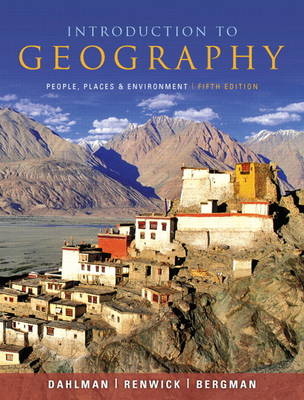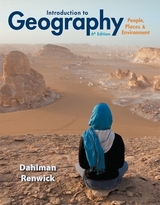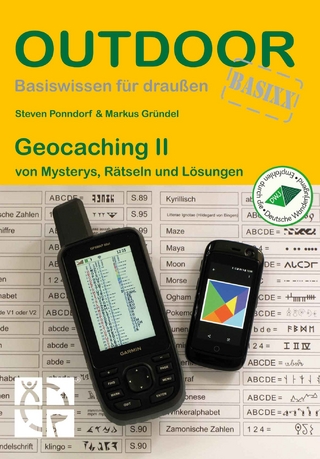
Introduction to Geography
Pearson (Verlag)
978-0-321-69531-4 (ISBN)
- Titel erscheint in neuer Auflage
- Artikel merken
Carl T. Dahlman earned degrees in sociology, music, and urban affairs before receiving his Ph.D. in geography from the University of Kentucky in 2001. He is an Associate Professor of Geography at Miami University where his teaching focuses on political geography, migration and mobility, and globalization. His current research includes the role of European integration in the geopolitics of Southeastern Europe. He enjoys photography and hunting for fossils with his son. William H. Renwick earned a B.A. from Rhode Island College in 1973 and a Ph.D. in geography from Clark University in 1979. He has taught at the University of California, Los Angeles, and Rutgers University, and is currently Associate Professor of Geography at Miami University. A physical geographer with interests in geomorphology and environmental issues, his research focuses on impacts of land-use change on rivers and lakes, particularly in agricultural landscapes in the Midwest. When time permits, he studies these environments from the seat of a wooden canoe. Edward F. Bergman was born in Wisconsin and received a B.A. from the University of Wisconsin, an M.A. and Ph.D. from the University of Washington. He taught at the City University of New York and widely in Europe, South America and South Africa. Now retired as a professor emeritus, he still travels and occasionally lectures and advises museums on the writing of labels for exhibits.
1. Introduction to Geography: A Look Ahead
1.1 What is Geography?
1.1.1 The Development of Geography
1.2 Contemporary Approaches in Geography
1.2.1 Area Analysis
1.2.2 Spatial Analysis
1.2.3 Geographic Systems Analysis
1.2.4 Human-Environmental Interaction
1.3 Describing Earth
1.3.1 The Geographic Grid
1.3.2 Communicating Geographic Information: Maps
1.3.3 Geographic Information Technology
1.3.4 GIS: A Type of Database Software
1.3.5 Integration of Information Technologies
Connections: Thematic Mapping
Connections: Online Mapping
2. Weather and Climate
2.1 Energy and Weather
2.1.1 Incoming Solar Radiation
2.1.2 Storage of Heat in Land and Water
2.1.3 Heat Transfer Between the Atmosphere and Earth
2.1.4 Heat Exchange and Atmospheric Circulation
2.2 Precipitation
2.2.1 Condensation
2.2.2 Causes of Precipitation
2.3 Circulation patterns
2.3.1 Pressure and Winds
2.3.2 Global Atmospheric Circulation
2.3.3 Seasonal Variations in Global Circulation
2.3.4 Ocean Circulation Patterns
2.3.5 Storms: Regional-Scale Circulation Patterns
2.3.6 A Snapshot of Global Circulation and Weather
2.4 Climate
2.4.1 Air Temperature
2.4.2 Precipitation
2.5 Classifying Climate
2.6 Earth’s Climate Regions
2.6.1 Humid Low-Latitude Tropical Climates
2.6.2 Dry Climates
2.6.3 Warm Midlatitude Climates
2.6.4 Cold Midlatitude Climates
2.6.5 Polar Climates
2.7 Climate Change
2.7.1 Climatic Change Over Geologic Time
2.7.2 Possible Causes of Climatic Variation
2.7.3 Global Warming
Connections: Climates in Urban Areas
Global and Local: El Nino/ La Nina
Rapid change: Assessment of Global Warming and Its Impacts
3. Landforms
3.1 Plate Tectonics
3.1.1 Earth’s Moving Crust
3.1.2 Types of Boundaries Between Plates
3.1.3 Rock Formation
3.2 Slopes and Streams
3.2.1 Weathering
3.2.2 Moving Weathered Material
3.3 Ice, Wind and Waves
3.3.1 Glaciers
3.3.2 Impact of Past Glaciations
3.3.3 Effects of Wind on Landforms
3.3.4 Coastal Erosion
3.4 The Dynamic Earth
3.4.1 Rates of Landform Change
3.4.2 Environmental Hazards
Global and Local: New Orleans: Rising Sea level, Hurricanes and Coastal Vulnerability
Connections: Wealth and Natural Hazards
4. Biogeochemical Cycles and the Biosphere
4.1 Biogeochemical Cycles
4.1.1 The Hydrologic Cycle
4.1.2 Water Budgets
4.1.3 Vegetation and the Hydrologic Cycle
4.2 Carbon, Oxygen and Nutrient Flows in the Biosphere
4.2.1 The Carbon and Oxygen Cycles
4.2.2 The Global Carbon Budget
4.2.3 Managing the carbon cycle
4.2.4 Deforestation, reforestation, and carbon offsets
4.3 Soil
4.3.1 Soil Formation
4.3.2 Soil Horizons
4.3.3 Thousands of Soils
4.3.4 Climate, Vegetation, Soil and the Landscape
4.3.5 Soil Problems
4.3.6 Soil Fertility: Natural and Synthetic
4.4 Ecosystems
4.4.1 Ecosystem Processes
4.4.2 Biodiversity
4.5 Biomes: Global Patterns in the Biosphere
4.5.1 Forest Biomes
4.5.2 Savanna, Scrubland, and Open Woodland Biomes
4.5.3 Midlatitude Grassland Biome
4.5.4 Desert Biome
4.5.5 Tundra Biome
4.5.6 Natural and Human Effects on the Biosphere
Global and Local: Carbon Emission Offsets
Connections: Geography, Geographic Information Systems and the Global Carbon Budget
Connections: Human-Dominated Systems
Connections: Fire and Forest Management in the Western United States
5. Population and Migration
5.1 The Distribution and Density of Human Settlement
5.1.1 Population Density
5.2 World Population Dynamics
5.2.1 Population Projections
5.2.2 Regional Variation in Population Growth
5.2.3 The Age Structure of the Population
5.2.4 The Demographic Transition
5.2.5 Factors Affecting Fertility Rates
5.2.6 Changes in World Death Rates
5.2.7 Is Earth Overpopulated?
5.3 Other Significant Demographic Patterns
5.3.1 Sex Ratios in National Populations
5.3.2 The Aging Human Population
5.4 Migration
5.4.1 Prehistoric Human Migrations
5.4.2 The Migrations of Peoples Since 1500
5.5 Migration Today
5.5.1 Forced Migration
5.5.2 The Impact of International Migration
5.5.3 Migration to Europe
5.5.4 Migrations of Asians
5.5.5 Migrations to the United States and Canada
5.6 Effects of Emigration
Connections: Environmental Disturbance and Disease
Rapid change: Demographic Collapse
Connections: The Economics of Aging
Global and Local: The East-West Exchange of Disease
Connections: Race, Culture, and the U.S. Census
6. Cultural Geography
6.1 Cultural Evolution Contrasts with Cultural Diffusion
6.1.1 Theories of Cultural Evolution
6.1.2 Cultures and Environments
6.1.3 Cultural Diffusion
6.2 Identity and Behavioral Geography
6.2.1 Grouping Humans by Race, Ethnicity, and Gender
6.2.2 Behavioral Geography
6.3 Culture Regions
6.3.1 Visible Clues to Culture Areas
6.3.2 Forces that stabilize the pattern of culture regions
6.3.3 Trade and Cultural Diffusion
6.3.4 World Trade and Cultural Diffusion Today
6.3.5 The Acceleration of Diffusion
6.3.6 The Challenge of Change
6.4 The Global Diffusion of European Culture
6.4.1 Europe’s Voyages of Contact
6.4.2 Economic Growth Increased Europe’s Power
6.4.3 Cultural Imperialism
6.4.4 Westernization Today
6.4.5 America’s Role
6.5 Cultural Preservation and Hybridity
Global and Local: Lahic
Rapid Change: Who Killed the Record Store?
Global and Local: Sworn Virgins of the Balkans
Connections: Is Latin America a Region? How Did It Get Its Name?
Global and Local: The Diffusion of News
7. The Geography of Languages and Religions
7.1 Defining Languages and Language Regions
7.1.1 Linguistic Geography
7.1.2 The World’s Major Languages
7.2 The Development and Diffusion of Languages
7.2.1 The Indo-European Language Family
7.2.2 Other Language Families
7.2.3 The Geography of Writing
7.2.4 Toponymy: Language on the Landscape
7.3 Linguistic Differentiation in the Modern World
7.3.1 National Languages
7.4 The Teachings, Origin, and Diffusion of the World’s Major Religions
7.4.1 Judaism
7.4.2 Christianity
7.4.3 Islam
7.4.4 Hinduism and Sikhism
7.4.5 Buddhism
7.4.6 Other Eastern Religions
7.4.7 Animism and Shamanism
7.5 The Political and Social Impact of the Geography of Religion
7.5.1 Religion and politics
7.5.2 Indirect Religious Influences on Government
7.5.3 Religion and Dietary Habits
7.5.4 Religion and Economics
7.5.5 Religions, Science, and the Environment
Rapid Change: The Rise of English
Global and Local: Language in New States
Connections: Religious Fundamentalism and Political Terrorism
Connections: Liberation Theology
Connections: Religious Tensions on the Indian Subcontinent
8. The Human Food Supply
8.1 Food Supplies Over the Past 200 Years
8.1.1 New Crops and Cropland
8.1.2 Transportation and Storage
8.1.3 Other Technological Advances
8.1.4 The Green Revolution
8.2 Agriculture Today
8.2.1 Subsistence Farming Contrasts with Commercial Farming
8.2.2 Types of Agriculture
8.2.3 What Determines Agricultural Productivity?
8.3 Livestock Around the World
8.3.1 The Direct and Indirect Consumption of Grain
8.3.2 Problems Associated with Animal Production
8.3.3 Dairy Farming and the Principle of Value Added
8.4 Aquatic Food Supplies
8.4.1 Traditional Fisheries
8.4.2 Modern Fishing
8.5 Hunger and Food Security
8.5.1 Problems in Increasing Food Production
8.5.2 Rich Countries Subsidize Production and Export of Food
8.5.3 Why Do Some Rich Countries Subsidize Agriculture?
8.6 Food Supplies in the Future
8.6.1 The Importance of Crop Diversity
8.6.2 The Scientific Revolution in Agriculture Continues
8.6.3 Resistance to Biotechnology
8.6.4 Climate Change and Food Security
8.6.5 Sustainable Agriculture
Connections: The Economic Geography of Food and Land: Von Thünen’s “Isolated City” Model
Global and local: New Uses for Old Crops
Rapid Change: Goodbye to the Banana?
Connections: Soybeans in Brazil
9. Earth’s Resources and Environmental Protection
9.1 What is a Natural Resource?
9.1.1 Characteristics of Resources
9.1.2 Substitutability
9.1.3 Renewable and Nonrenewable Resources
9.2 Geologic and Energy Resources
9.2.1 Mineral Resources
9.2.2 Variations in Mineral Use
9.2.3 Depletion and Substitution
9.2.4 Disposal and Recycling of Solid Waste
9.2.5 Energy Resources
9.2.6 Energy from Fossil Fuels
9.2.7 Nuclear and Renewable Energy Resources
9.3 Air and Water Resources
9.3.1 Air Pollution
9.3.2 Water Resources
9.3.3 Water Pollution
9.3.4 Reducing Air and Water Pollution
9.4 Forests
9.4.1 Forests as Fiber Resources
9.4.2 Other Important Forest Uses
9.4.3 Balancing Competing Interests
Rapid Change: Peak Oil
Connections: Meat Production and Water Pollution
10. Cities and Urbanization
10.1 Urban Functions
10.1.1 The Three Sectors of an Economy
10.1.2 The Economic Bases of Cities
10.2 The Locations of Cities
10.2.1 Central Place Theory
10.2.2 Urban Hierarchies
10.2.3 The Patterns of Urban Hierarchies
10.3 World Urbanization
10.3.1 The Rise of Urbanized Societies
10.3.2 Urbanization Today
10.3.3 Government Policies to Reduce the Pull of Urban Life
10.3.4 Improving Rural Life
10.3.5 The Economic Vitality of Cities
10.4 The Internal Geography of Cities
10.4.1 Economic Forces
10.4.2 Social Factors in Residential Clustering
10.4.3 Government’s Role
10.4.4 Other Urban Models in Diverse Cultures
10.5 Cities and Suburbs in the United States
10.5.1 The Growth of Suburbs
10.5.2 The Social Costs of Suburbs
10.5.3 Suburbs as Sites of Change
10.5.4 Developments in the Central City
10.5.5 Efforts to Redistribute Jobs and Housing
10.5.6 Governing Metropolitan Regions
10.6 Cities and the Environment
Rapid Change: Urbanizing China
Connections: Public Space and Private Property
Rapid Change: Controlling Sprawl in Metropolitan Portland, Oregon
11. A World of States
11.1 The Development of the Nation-State Idea
11.1.1 The Idea of the Nation
11.1.2 The Nation-State Idea
11.1.3 The European Nation-States
11.1.4 The Collapse of Empires
11.1.5 British Empire to Commonwealth
11.1.6 The French Empire
11.1.7 The Successor States of the Ottoman Empire
11.2 A Changing World Political Map
11.2.1 Centripetal Forces
11.2.2 Centrifugal Forces
11.2.3 Ethnic Cleansing and Genocide
11.3 The Internal Organization of States
11.3.1 Types of Regimes
11.3.2 The Shapes of States
11.3.3 International Borders
11.3.4 Territorial Subdivision and Systems of Representation
11.3.5 Districting and Redistricting
11.3.6 Individual Rights and Freedoms
11.4 Relations Among States
11.4.1 Patterns of Cooperation
11.4.2 Geographies of Conflict
11.4.3 Jurisdiction over Earth’s Open Spaces
11.4.4 Globalization’s Challenge
Rapid Change: Geopolitics
Connections: Nigeria
Rapid Change: Continuous Redistricting and Gerrymandering in the United States
Global and Local: U.S. Border Security
12. Paths to Economic Growth
12.1 Analyzing and Comparing Countries’ Economies
12.1.1 Measures of Gross Product and Their Limitations
12.1.2 Gross Domestic Product and the environment
12.1.3 The Gross National Product and the Quality of Life
12.1.4 Preindustrial, Industrial, and Postindustrial Societies
12.1.5 Why Some Countries Are Rich and Some Countries Are Poor
12.2 The Geography of Manufacturing
12.2.1 Locational Determinants for Manufacturing Today
12.2.2 Locational Determinants Migrate
12.2.3 Manufacturing in the United States
12.2.4 The Economy of Japan
12.2.5 Technology and the Future Geography of Manufacturing
12.3 National Economic-Geographic Policies
12.3.1 Political Economy
12.3.2 Wealth Variations within States
12.3.3 How Do Governments Distribute Economic Activities?
12.3.4 National Transportation Infrastructures
12.4 National Trade Policies
12.4.1 The Import-Substitution Method of Growth
12.4.2 Export-Led Economic Growth
12.5 The Formation of the Global Economy
12.5.1 Transnational Investment and Production
12.5.2 The International Tertiary Sector
12.5.3 The Geography of Foreign Direct Investment
12.5.4 The Globalization of Finance and Risk
12.5.5 International Regulation of the Global Economy
Rapid Change: Recession and the Crisis for U.S. Automakers
Connections: Socks and Politics
Global and Local: India’s New Roads
Global and Local: Tourism
Rapid Change: The Financial Crisis
Rapid Change: The Rise of the BRIC and the G-20
13. Global Challenges and the Scale of Response
13.1 Protecting the Global Environment
13.1.1 Energy Consumption
13.1.2 Energy Efficiency Trends
13.1.3 Development, Pollution and the Quality of Life
13.1.4 International Equity in Environmental Management
13.2 Global Security and Human Rights
13.2.1 Interests Versus Principles
13.2.2 Human Rights and National Sovereignty
13.2.3 Humanitarian Intervention
13.2.4 Kosovo and Iraq: Signs of the Times?
13.2 Regional Cooperation
13.2.1 European Integration
13.2.2 NAFTA and the Americas
13.2.3 Expanding Western Hemisphere Free Trade
13.2.4 Other Forms of Regional Cooperation
13.3 Human Development
13.3.1 Measuring Development
13.3.2 The Role of the Environment
13.3.3. Millennium Development Goals
13.4 Geography and Thinking Globally
Connections: Water Privatization
Connections: Malaria and DDT
Global and Local: Living with Landmines
Connections: The Importance of Water for Human Development
| Erscheint lt. Verlag | 11.11.2010 |
|---|---|
| Sprache | englisch |
| Maße | 276 x 216 mm |
| Gewicht | 1140 g |
| Themenwelt | Naturwissenschaften ► Geowissenschaften ► Geografie / Kartografie |
| ISBN-10 | 0-321-69531-3 / 0321695313 |
| ISBN-13 | 978-0-321-69531-4 / 9780321695314 |
| Zustand | Neuware |
| Haben Sie eine Frage zum Produkt? |
aus dem Bereich



